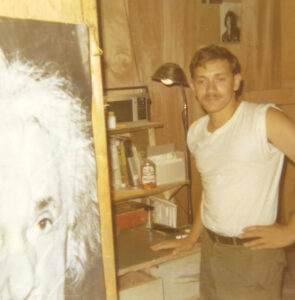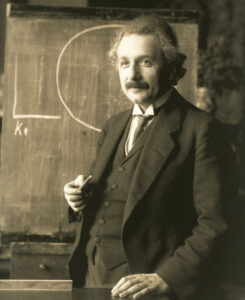
Photo by RhondaK at Unsplash
You overhear Sam, a man in his mid-forties, say to a much younger man: “Only the young can be creative.” Einstein said something similar:
Anything truly novel is invented only during one’s youth. Later one becomes more experienced, more famous – and more blockheaded!
These beliefs can resonate with the young who feel pressure to create. They can resonate with the old who feel resigned to their fate. Einstein was my hero. I hung a large poster of him while in Vietnam during the war and carried it around for a year. I once held Sam and Einstein’s beliefs.

The author in Vietnam, March 1970
What does Sam mean by “creativity?” Alan Bowness, in his book on European art, asked: “Does creation reside in the idea or the action? Is Sam concerned only with generating ideas? Does he mean creating inventions or innovating in the marketplace? Here, assume he uses any of the words be creative, be inventive, or be innovative in his belief statement.
What can we say to Sam to change his perspective? Our approach is like an eye examiner. We keep changing the lenses in front of someone’s eyes until a new world comes into view. Here, we take a statement, define a context, and practice providing wide-ranging responses. It is like a “what if” exercise on steroids. What follows are challenges Sam’s belief.
Old Masters and Young Geniuses

Photo from pixabay.com
Talk to Sam about research into the different ways people create innovations during their life. David Galenson, author of Old Masters and Young Geniuses, discovered something interesting. There are two life cycles of creativity among the lives of people within a particular field. Some people made significant contributions early in their career, and others much later. He called the former conceptual innovators and the later experimental innovators.
Einstein is an example of the former. He published his theory of general relativity (theory of gravity) when he was 36. Darwin is an example of the later. He published his general theory of evolution when he was 50 and his thoughts on the evolution of man when he was 62.
According to Galenson, conceptual innovators think deductively. For each of his theories, Einstein reasoned from first principles. Special relativity comes from the principle: the speed of light in a vacuum is the same for any observer. General relativity comes from another principle about the perception of acceleration. Suppose we wake up and find ourselves accelerating in a spaceship with no windows. Einstein said there is no way to tell if the acceleration is due to the gravitational pull of a planet, or to the thrust of our propulsion engines.
Experimental innovators think inductively. Galenson provided examples illustrating Darwin was an inductive empiricist. Darwin did not deduce a theory from first principles. Instead, he inferred one by accumulating evidence over a long period. When you use induction, it is sometimes difficult to decide when you have enough evidence. Galenson has a rich description of each archetype with examples in many fields.
An Interlude – Barriers to Creativity

Photo by Connor McSheffrey on Unsplash
Sam’s belief could be a coping mechanism. Its positive intent could be to protect himself. The belief might stop him from acting because of a fear of success or a fear of failure. Or Sam might have a strong sense of self-importance and see no need to be creative. He may think he is at the pinnacle of his career.
What else could he learn? He would rather leave what little remains to the young to uncover. This reminds me of the state of physics in the 19th century after the discovery of Maxwell’s equations. Most physicists thought there was little left to discover, except some minor problems. Then came Einstein, Schroder, and many others to bring in the dawn of a new era.
Final Frames

Photo by Michael Dziedzic on Unsplash
Let’s explore some other scenarios. Sam might think he has to be creative all by himself and not as part of a team. IDEO is a company that creates innovative product designs. For design projects, they enlist people whose collective experience can span ten roles. These many perspectives help foster ideas. They also help counter nay-sayers, who raise concerns and kill new ideas. Here are a few roles: anthropologist, experimenter, hurdler, storyteller and cross-pollinator.
Alexander Graham Bell said:
Leave the beaten track and dive into the woods, Every time you do so, you will be certain to find something you have never seen before.
IDEO associates this quote with a cross-pollinator. I like to think of it as bringing one field to bear on another. We can bring state-management from Neuro-semantics to help writers harness their creative energy. I use epidemiology to understand the viral spread of warfare among the ancient Maya. Sam could look to other fields to bring new insights to his own. To do this, he might have to abandon any “not invented here” thoughts.
Would having Sam’s belief stop you from being innovative? If so, has anything I said changed your frame of mind? Do you want to be an idealist who dreams of creative acts, or an innovator who acts on creative dreams?
Further Reading
Galenson, D. (2006). Old Masters and Young Geniuses: The Two Life Cycles of Artistic Creativity. Princeton; Oxford: Princeton University Press.
Galenson, D, & C. L. Pope (2013). Experimental and Conceptual Innovators in the Sciences: The Cases of Darwin and Einstein, Historical Methods: A Journal of Quantitative and Interdisciplinary History, 46:2, 102-112
Gambardella, P. (2018). Three Doors into Summer: Bringing One World to Bear on Another.
Gambardella, P. (2017). Being Someone Else and the Game of the Gatekeepers.
Kelley, T, and J. Littman (2005). The Ten Faces of Innovation: IDEO’s Strategies for Beating the Devil’s Advocate & Driving Creativity throughout Your Organization. New York: Doubleday.
Acknowledgements
I would like to thank my editor (and wife), Claire Kurs.
Views: 165
 Pascal is a master modeler, who has modeled physical phenomena, satellite motion, and the behavior of people, organizations, and corporations.
Pascal is a master modeler, who has modeled physical phenomena, satellite motion, and the behavior of people, organizations, and corporations.